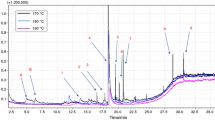Abstract
Lignin has enormous potential for use as a raw material in the polymer industry. However, lignin has not been utilized as a raw material despite its many advantages because of its brittleness and difficulty of processing. Chemical modification of lignin is an important area of lignin research. In this study, two types of alkyl-chain-based modification agents were used. In the case of the polymeric materials blend, polymers are blended well so that the polymer solubility parameter (SP) values are close to each other. This is similar to the well-mixed combination of water and alcohol. If the SP value is very different, phase separation occurs, as in the relationship between water and oil. The two alkyl chain derivatives block the hydroxyl groups of lignin and replace them with glycoside. Moreover, they can alter the SP value of the modified lignin to make it similar to that of a synthetic polymer to enable blending. Cellulose is compatible with hemicellulose, which is coupled to lignin by ether, glycoside, and ester bonds in plant fibers. To mimic this structure, in this study, lignin was combined with an alkyl chain with a similar SP value and was used as a matrix polymer to form glycoside bonds. This relationship between lignin and the alkyl chain is similar to that between the cellulose and lignin-carbohydrate-complex (LCC). PLA-modified lignin (PLAL) and tetrahydrofuran-modified lignin (THFL) exhibited remarkable changes in the presence of an alcohol functional group. The results of 1H-NMR analysis confirm those obtained by FT-IR analysis. The results of the DSC analyses indicate that lignin and modified lignin exhibit different thermal properties. The results of the thermal and mechanical analyses of the modified lignin/PLA blends demonstrate that the characteristics of the alkyl chains used to modify lignin were well reflected in the final blends. Alkyl-chain-modified lignin that mimics LCC was observed to enhance the compatibility between the matrix polymers used in this study and modified lignin.
Similar content being viewed by others
References
J. L. McCarthy and A. Islam in “Lignin: Historical, Biological, and Materials Perspectives” (W. G. Glasser, R. A. Northey, and T. P. Schultz Eds.), ACS Symp. Ser. 742, pp.2–99, American Chemical Society, Washington, 2000.
S. Kubo, R. D. Gilbert, and J. F. Kadla in “Natural Fibers, Biopolymers, and Biocomposites” (A. K. Mohanty, M. Misra, and L. T. Drzal Eds.), p.674, Taylor and Francis, Boca Raton, 2005.
D. Feldman, D. Banu, M. Lacasse, J. Wang, and C. Luchian, J. Macromol. Sci.-Pure Appl. Chem., A32, 1613 (1995).
H. Yoshida, R. Morck, K. Kringstad, and H. Hatakeyama, J. Appl. Polym. Sci., 34, 1187 (1987).
D. Feldman, C. Luchian, D. Banu, and M. Lacasse, Cell. Chem. Technol., 25, 163 (1991).
J. Nakano, Y. Izuta, T. Orita, H. Hatakeyama, K. Kobashigawa, K. Teruya, and S. Hirose, Sen-I Gakkaishi, 53, 416 (1997).
H. Yoshida, R. Morck, K. Kringstad, and H. Hatakeyama, J. Appl. Polym. Sci., 40, 1819 (1990).
Z. X. Guo, A. Gandini, and F. Pla, Polym. Int., 27, 17 (1992).
Z. X. Guo and A. Gandini, Eur. Polym. J., 27, 1177 (1991).
D. Fengel and M. Przyklenk, Wood Sci. Technol., 10, 312 (1976).
T. Koshijima, T. Watanabe, and F. Yaku in “Lignin: Properties and Materials” (W. G. Glasser and S. Sarakanen Eds.), pp.15–26, ACS Symp. Ser. 397, Washington, 1989.
H. H. Nimz, Tappi J., 56, 124 (1973).
J. Burke, “Solubility Parameters: Theory and Application”, Vol. 3, The Book and Paper Group Annual, The American Institute for Conservation, Oakland, USA, 1984.
T. Setoyama, M. Kobayashi, Y. Kabata, T. Kawai, and A. Nakanishi, Catalysis Today, 73, 2930 (2002).
W. Thielemans and R. P. Wool, Biomacromolecules, 6, 1902 (2005).
C. M. Hansen, “Hansen Solubility Parameters: A User’s Handbook”, 2nd ed., pp.282–283, CRC Press, Boca Raton, 2007.
R. C. Sun, X. F. Sun, S. Q. Wang, W. Zhu, and X. Y. Wang, Ind. Crop. Prod., 15, 179 (2002).
K. A. M. Thakur, R. T. Kean, E. S. Hall, J. J. Kolstad, and E. J. Munson, Int. J. Polym. Anal. Charact., 4, 393 (1998).
C. A. Cateto, M. F. Barreiro, A. E. Rodrigues, and M. N. Belgacem, Ind. Eng. Chem. Res., 48, 2583 (2009).
A. J. Nijenhuis, E. Colstee, D. W. Grijpma, and A. J. Pennings, Polymer, 37, 5849 (1996).
P. M. Chou, M. Mariatti, A. Zulkifli, and M. Todo, Polym. Bull., 69, 455 (2012).
C. M. Hansen, “Hansen Solubility Parameters: A User’s Handbook”, 2nd ed., pp.493–505, CRC Press, Boca Raton, USA, 2007.
D. Braga, F. Grepioni, L. Maini, and M. Polito, Struct. Bond., 132, 27 (2009).
J. Baldrian, M. Horký, M. Steinhart, A. Sikora, M. Mihailova, H. Amenitsch, S. Bernstorff, and G. Todorova, Fibres Text. East. Eur., 11, 46 (2003).
Author information
Authors and Affiliations
Corresponding author
Rights and permissions
About this article
Cite this article
Kim, S., Oh, S., Lee, J. et al. Effect of alkyl-chain-modified lignin in the PLA matrix. Fibers Polym 15, 2458–2465 (2014). https://doi.org/10.1007/s12221-014-2458-z
Received:
Revised:
Accepted:
Published:
Issue Date:
DOI: https://doi.org/10.1007/s12221-014-2458-z




